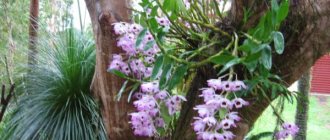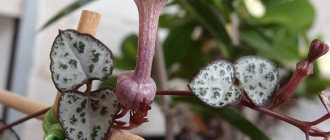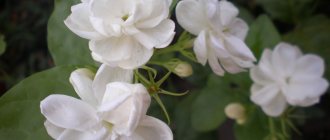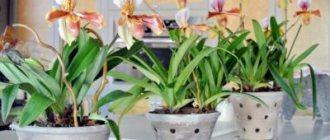A large number of hybrid varieties of Cumbria with bright large flowers find their admirers everywhere. The flower is becoming increasingly popular among flower growers, as it is an excellent decoration not only for home interiors, but also for offices in public buildings. The plant does not require much attention or special knowledge to successfully grow it indoors. To ensure that Cambria grows healthy and delights you with abundant flowering every year, we will tell you about all the features of caring for it at home.
Location and lighting
For the flower, choose a place in the apartment on a permanent basis, as it does not like frequent rearrangements. It is advisable for the pot to stand near a window in a western or southwestern direction. Its place should be light or slightly shady. The western windows will have the most favorable amount of sunlight.
There is too much ultraviolet radiation on southern windowsills. Direct sunlight can burn Cambria leaves. If the house has only south-facing windows, place the flower at the back of the room in light partial shade, or at midday, protect the pot standing on the windowsill from the sun using blinds or light curtains.
Daylight hours for Cumbria should be about 12 hours. In winter, you will have to maintain this indicator with the help of a phytolamp or other fluorescent lamp. During periods of conditional dormancy, the flower does not need to be illuminated.
Conditions of detention
Cambria is not capricious. But for full development and abundant flowering, the plant must be provided with the best conditions.
Temperature
In order for the Cambria orchid to grow normally, it is kept at a temperature of +16-20 °C. Cambria is thermophilic, but reacts painfully to heat and slows down its growth. Night temperature fluctuations are unacceptable. The difference between day and night temperatures should not be more than 5 °C.
Air humidity
Cambria orchid is not capricious in terms of air humidity. If the flower pot is located close to the heating radiator, then the air humidity must be increased artificially. To do this, place a container filled with water next to the flower.
Regular spraying of foliage is also beneficial for the orchid. But when spraying water, the spray bottle must be kept away from the plant so that large drops do not remain on the leaves, which can cause yellow spots to appear.
Illumination
Cambria is light-loving, it should be in a well-lit room. However, the light should be diffused; the orchid should not be exposed to direct sunlight. Intense ultraviolet light burns the surface of the leaves, causing yellowing. The optimal place for an orchid is a window in the west or east.
If there is a lack of natural light in the winter months, it is necessary to install phytolamps. But if the plant is at a dormant stage, then there is no need to disturb it with additional light. The optimal length of daylight for an orchid is 10-12 hours.
Priming
To grow orchids, purchase special soil, including:
- pieces of sphagnum moss;
- crushed pine bark;
- a small amount of charcoal to prevent oxidation of the substrate;
- expanded clay as an aerator.
Top dressing
Fertilizer application begins when young shoots appear on the orchid, and is completed when the flowering phase begins. Cambria has a thin and sensitive root system. In order not to injure the roots, low concentration fertilizers are prepared: for the solution, take 2 times less of the drug than indicated on the package.
Watering
Water the plant when the substrate dries out. During the summer months, watering is usually done once a week. With the arrival of winter, the frequency of watering is significantly reduced. Watering is done using the bottom method: the flower pot is placed in a basin of water. Use only settled, lukewarm water.
Seasonal care features
The peculiarity of the Cambria orchid is that it does not have a pronounced resting phase; with quality care, it can bloom all year round. Moreover, the flowering shoots come out one by one: one fades, the other appears. Therefore, flowering is virtually continuous.
Spring
With the onset of spring, an orchid standing on a windowsill must be protected from bright sunlight. If the room temperature is no more than 18-20 °C, then there is no need to moisten the flower abundantly.
Summer
During the summer months, the orchid's delicate leaves provide protection from direct sunlight. The optimal summer temperature for the plant is no higher than +25 °C. If the weather is hot, then humidify the air around the flower. For spraying use a fine spray. In summer, the orchid can be taken out onto the balcony or into the yard. Place it where there are no drafts, where raindrops and direct rays of the sun do not fall.
Autumn
With the arrival of autumn, the flower begins to lack sunlight. Cambria may go into a dormant phase, or it may remain active and produce flower stalks. In the first case, the plant is not disturbed with additional light, in the second, phytolamps are installed.
Winter
If Cambria continues to bloom in the winter months, then artificial lighting is indispensable. The optimal winter air temperature for the plant is 16-20 °C.
How to care during and after flowering
Cambria blooms most actively in autumn and winter. In the spring-summer period, pseudobulbs form on the shoots, and flower stalks emerge from the leaf axils. In order for winter flowering to be beautiful and complete, phytolamps must be used.
When the pseudobulb is formed, the plant is not moistened for two weeks. Then water, but not abundantly. This sequence of actions ensures lush flowering of the orchid. Watering is resumed in the same volume after the flower stalks emerge from the leaf axils. If overwatered at the end of the growing season, Cambria may stop blooming.
Watering
Abundant watering of Cambria is required only during the germination of pseudobulbs and the appearance of flower shoots. The rest of the time, watering should be moderate. We do not recommend over-filling or completely drying out the soil in the pot. The substrate should be slightly damp and dry well between waterings. In the summer, we water on average once a week.
Water for irrigation should be soft, room temperature (filtered, boiled). Even tap water left standing for 24 hours can lead to salinization of the substrate.
For watering, use both regular, surface watering and the immersion method. Do it this way: place the pot with Cambria in a basin or other container larger than the size of the pot, pour water suitable for watering into it up to the middle of the pot or slightly higher (provided there are good drainage holes in the bottom of the pot). After 15-20 minutes. remove the pot from the bowl and allow excess water to drain. When Cambria has bloomed and is at rest, it can be left immersed in water for a longer time.
For convenient surface watering, we recommend purchasing a special watering can with a narrow and long spout. If, during watering, moisture gets on the root collar or remains in the axils of the leaves, you should blot it with a paper napkin so as not to provoke rotting.
The plant does not bloom. What to do?
Typically, varietal cambria bloom once a year. Flowering duration is from three to seven weeks. If your Cambria orchid has faded, you need to increase its care. Dry flower stalks are cut off, and the period of feeding and drying begins. That is, the orchid continues to be watered as usual, with fertilizers added to the water, until the process of forming a new pseudobulb is completed. Once this process is over, the plant is stopped watering altogether for two to three weeks. During this time, peduncles are formed, which soon emerge from the base of the bulb. The period of rest and growth of a new bulb can be about 10 months in total.
The beautiful Cambria feels great at home and can bloom for more than one year. The main thing is to comply with the specified conditions of agricultural technology.
Source – makgreen.ru
Humidity
The humidity of the surrounding air plays a small role in the life of the flower, although its ancestors were from the American tropics. 40-60% is enough all year round. If the air in the apartment is too dry, especially during the heating season, then it needs to be humidified, for example, like this:
- spray the space around the plant without getting the spray on the leaves;
- place a wide container of water near the flower to evaporate it;
- cover the hot radiator with damp towels;
- If you have a household humidifier, turn it on (if necessary).
Top dressing
Considering the peculiarities of irrigation in Cambria, when nutrients are constantly washed out of the soil, they should be replenished in a timely manner with the help of mineral and organic fertilizers created specifically for orchids. They contain amino acids and vitamins, potassium, nitrogen and phosphorus. The acidity indicator should be at pH level 5-7. Such fertilizers help improve the immune system of orchids.
During the growing season, in spring and autumn, when young shoots appear, we recommend feeding the plant once every 15 days with liquid fertilizers for orchids. In summer or winter, during flowering, fertilize less frequently, once a month. Add fertilizer to the water during immersion. Measure the dose of the drug strictly according to the instructions - follow the manufacturer’s instructions.
Conventional complex mineral fertilizers are not suitable for flowering indoor plants - they are too concentrated and can burn the delicate roots of the Cambria orchid.
After planting or replanting Cambria, do not fertilize for a month. When the buds are opening, also wait a while with fertilizers, then flowering will last longer.
How should you care for this noble lady?
If your windows face different sides of the world, “attribute” cambria to the eastern or western windowsill (the northern one is too dark for it, and the southern one, on the contrary, is too sunny)
It is important that the light is bright, but diffused, and the rays do not fall directly on the leaves and flowers of the orchid
As for air temperature, this flower is thermophilic. The gold standard for it: from 16 to 28 degrees
Moreover, it is important that the day and night temperatures in the room are almost the same - temperature jumps are destructive for cambria
The gardener should be most careful in the off-season, especially in mid-autumn: make sure that the temperature in the cold house is not below 14 degrees, otherwise the orchid will freeze and it will be difficult to save it.
What kind of watering does Cambria like?
- Abundant - if the flower's life cycle enters the active phase. That is, new pseudobuds grow or a peduncle arrow grows.
- Abbreviated - if nothing interesting happens in the life of the orchid.
- Stop watering when the flower enters the dormant phase (winter).
Important: never water a flower if the substrate is wet. It should dry so that the pieces of bark rustle
It is interesting that Cambria is the case when watering a flower is indicated not by transparent roots, but by dried soil (this plant can generally be kept in an opaque pot, since its roots do not need light as much as the roots of phalaenopsis).
Water can be poured directly into the pot (on the soil, but not on the stem). But most of all, Cambria likes it when the pot is immersed in a container of water (the so-called immersion watering).
During this procedure, remember: it is better to place a few pebbles on top of the pot so that the bark does not start to float.
Like all other orchids, this plant loves settled (frozen, soft) water at warm, room temperature.
Spraying the flower is contraindicated (drops of water may cause “rashes” in the form of brown spots to appear on the leaves).
However, during the period of hot radiators, as well as in the spring, when your pet will grow its pseudobulbs, it is very desirable to increase the air humidity near the pot with cambria. This can be done by placing a tray under the pot filled with moistened expanded clay or pebbles.
Fertilizers: do you need to feed it?
It is necessary, and how! You can remember about the first feeding in the spring, as soon as the bulbs begin to gain strength. This can be a complex mineral fertilizer.
But dilute it weakly, adding twice as much water as written on the package. The fact is that the roots of this type of orchid are very weak, and food that other flowers will like will simply burn them.
You need to fertilize the flower in different ways, alternating them (but in no case using them together):
- Root method. Fertilizers are added during bottom watering (the pot is placed in a bowl of water, which the flower absorbs with its roots through holes in the pot).
- The foliar method is also known as the leaf method. Fertilizer is applied by spraying from a spray bottle, and you cannot spray it on the flowers. But remember: it was already said above that cambria does not like spraying, so you can only decide on this type of feeding if the root system of the flower is damaged. The sprayer must be particularly finely dispersed.
The plant needs to be fed once every 2-4 weeks. Moreover, it is better to underfeed this delicate pet than to overfeed it.
And when your pet blooms, you can put it on a “diet” (until flowering ends and new pseudobulbs begin to grow).
Soil and replanting
Every 2-3 years the plant outgrows its pot and needs to buy a larger one. Or another case: the substrate cakes and becomes salty (if the water in your house is too hard), so it needs to be changed.
What soil should I buy? Store-bought soil for epiphytes (orchids), medium or fine, is suitable. If it is constantly hot in your area, add a little agroperlite to the soil.
You can choose any pot, either plastic or ceramic, and, as mentioned above, opaque.
This orchid, like its fellows, needs drainage, so place a large piece of bark at the bottom of the pot.
When replanting an orchid, the roots deepen and the bulbs are placed on top of the soil - they cannot be sprinkled. This procedure is a lot of stress for the plant, so let it go: for a week after transplanting, do not touch the pot at all.
The orchid cannot be watered, fed, or even moved to another place.
Priming
As we have already written, the soil for Cambria should be light, selected specifically for orchids. This soil mixture is easy to purchase in stores. However, you can prepare a similar substrate yourself. You will need wood (pine) bark, again, charcoal (pieces), fern fraction, coconut fiber or pieces of polystyrene foam. It is better not to use sphagnum moss.
To prevent parasites and all kinds of infections, we recommend rinsing the substrate thoroughly under hot water, or better yet, boiling it.
Bulbs and pseudobulbs
Bulbs are tubers located underground, like potatoes. Orchids have pseudobulbs. They are called differently: tuberidia, aboveground or aerial tubers. They received this name due to the fact that they are above the ground.
They also differ from ordinary bulbs in color; they are usually green. The size of tuberidia varies depending on the type of orchid: they can be very small, or they can grow up to 15 cm. Pseudobulbs have different shapes - elongated, round, spherical.
Important! The main function of false bulbs is to store water and nutrients. The life span of pseudobulbs ranges from 1 to 5 years.
Pot
For the Cambria orchid, a non-transparent pot is better suited, since its roots do not participate in photosynthesis. A good choice would be ceramic, unglazed - to avoid stagnation of moisture and, as a result, rotting of the roots. The pot for the bush should be selected in such a size that its root system is evenly distributed throughout the entire volume, and there is space left up to the walls of the pot for its growth. If the pot is small, then the overgrown roots simply will not have room to develop in a healthy way. But a pot that is too large for a small plant is also not acceptable - the substrate in it will turn sour.
This may be interesting: Types and varieties of Phalaenopsis orchids
Cumbria transplant rules
If you have just purchased a pot of blooming Cambria, do not rush to replant it. During flowering, transplanting any flowers is not advisable, and for Cumbria this will result in the rapid end of flowering. The nutritional value of the transport substrate is not significant for it, because its own pseudobulbs are a kind of organic container for the flower’s nutrition and moisture. We recommend waiting at least until next spring.
But there are exceptions. Sometimes shipping pots are filled with moss. It should be removed and the resulting space should be filled with a substrate suitable for the orchid.
Cambria does not need frequent transplants. The painful reaction to transplantation is due to the fact that in Cambria the roots grow firmly with lumps of substrate, drainage and even the inner walls of the pot. Even with the most careful procedure for extracting a flower, it is difficult to avoid damage, and when immersed in a new substrate, the root endings may die. Therefore, replant a healthy plant no more often than once every two to three years, when you see that the roots are sticking out of the pot or the substrate is too compacted. Perform planned transplants in the spring.
When a transplant is still needed
There are reasons why it is worth replanting Cambria, even a flowering one, without waiting for the right period for this - the pot is too small, soil salinity and plant disease. We already wrote about the pot, but the soil becomes salty for many reasons:
- from constant waterlogging;
- in the absence of drainage holes in the bottom of the pot;
- with insufficient drainage layer;
- when excess water stagnates in the pan;
- when watering with hard tap water.
In any case, the roots may begin to rot, the plant will lose its decorative appearance, and may become ill and die. Don't wait for spring, act.
Transplantation process
Perform the Cambria transplant in the following sequence.
- Prepare a new pot 2-3 cm wider than the previous one. Place several large stones on the bottom as drainage to stabilize the pot (expanded clay is not suitable, it is light and, moreover, will contribute to soil salinity), then large pieces of bark in a layer of 2-3 cm, then smaller pieces of the same bark . To enhance drainage, you can add pieces of pumice and peat slabs. Apply a third layer of the orchid substrate.
- Remove the plant from the old pot. To avoid damaging the root system during extraction, we recommend watering the substrate well beforehand. Then the old soil will be easier to separate from the roots.
- Examine the root system of the flower. If necessary, trim away damaged or rotten parts of the roots with a sharp, clean knife. Treat the sections with crushed activated carbon or cinnamon. If there are many rotten areas, use fungicides. After treatment, leave the roots to dry for at least 2-3 hours in the air in the shade (you can leave them in the dark overnight).
- Place the Cambria bush in the center of the pot, spreading the roots along the sides. Wringing and tucking them is strictly prohibited. Cover the roots with the remaining substrate so that the pseudobulbs remain on the surface. To distribute the substrate evenly, lightly shake the pot or tap the sides with your fingers.
The first watering should be carried out depending on how many hours the orchid was dried. If all night, then water immediately after transplanting, but moderately. When the drying process took several hours, it is better to water it after three or four days. If you thoroughly soaked the prepared substrate with water before planting, then the first watering of Cambria after planting can be postponed for a week.
For a week after transplantation, keep the flower in partial shade, do not disturb or feed it. This will allow the orchid to go through the adaptation process faster.
Conditions for growing Cambria orchids at home
Caring for and maintaining the Cambria orchid at home requires strict adherence to all growing conditions, which include the correct choice of location for the plant, an ideal pot and soil. Only the combination of all conditions can guarantee a beautiful and blooming orchid flower.
Placing the Cambria orchid indoors
First of all, before deciding to purchase a Cambria group orchid, it is important to think about the most suitable location for the flower crop. In this case, special attention should be paid to issues of lighting and temperature. So, to obtain a healthy and lush flower, it is best to give preference to window sills on the east or west side. There is an optimal combination of sunny and shaded periods of the day. If this is not possible, and the pots are located in the southern parts of the room, then during especially hot periods it is necessary to shade the plants with gauze. Sometimes in winter there is not enough lighting, since the Cambria orchid requires daylight within 10-12 hours
In this case, you can use phytolamps. When choosing the optimal location for a pot of Cambria orchid, it is important to consider the temperatures required by this plant. For full growth and abundant flowering, you need to adhere to a temperature range of 16-21 degrees.
Choosing a pot and soil for the Cambria orchid
When planting and growing this group of orchids, it is important to pay special attention to the selection of soil. For this plant you need to take crushed sphagnum, as well as pieces of pine bark. Small pieces of wood ash need to be added to this earth mixture to prevent oxidation of the bark. To make the soil light and breathable, it is recommended to add expanded clay, pumice or pieces of foam. You can purchase special soil for planting orchids at a garden store, then select the largest pieces from it and place them in pots. If you use bark brought from the forest, be sure to boil and dry it to avoid various flower diseases. You need to be careful when choosing a pot or container for the Cambria orchid.
Unlike other types of orchids, this group prefers to grow in pots that do not allow sunlight to pass through at all. In this case, you can take clay or plastic ones; ceramic and coconut ones are also suitable. The size of the pots should be a few centimeters larger than the previous one so that the roots of the Cambria orchid can be placed freely along the walls.
Buying a Cambria orchid in a store
If you have just decided to purchase a Cambria group orchid, then it is best to go to a specialized garden store, which offers a large assortment of high-quality varieties of this flower. It is important to choose the right flower in the store so that after transportation to your home it can adapt and bloom. You should not buy a Cambria orchid with one pseudobulb, since in this case there is a high probability that the plant will not survive and will soon die. For full growth of an orchid, at least 2-3 bulbs are required, so it is worth checking the soil surface especially carefully for the presence of bulbs. Also check the upper part of the plant; the leaves and peduncles should be firm and fresh, have a bright and rich color.
Resuscitation of Cambria without a root system
If your Cambria has lost its roots for some reason, it has a chance to recover. Try different ways, we will help you with this.
- Remove the flower from the pot, free the root collar from the soil and trim off the dead roots. Treat the cut area with a fungicide. Leave the orchid to air dry in the shade for a while, about two hours. Then treat the cut with some rooting preparation (for example, Kornevin). Next - according to your choice.
- You can plant a bush without roots in a new (or old, treated with boiling water or fungicide) pot with a new substrate suitable for the orchid. Until it takes root, you will have to secure Cambria to the support using suitable devices. Don't rush to water. Spray the leaves of the plant with warm soft water, try to keep the moisture on their surface. But not in the sinuses. After two sprays on the third, add Fundazol to the water according to the instructions for use. We hope that after some time your Cambria will grow new roots and pseudobulbs.
- You can also place a bush without roots in water while the roots grow. Make a mark on the jar and add water as it evaporates to this mark. Use only soft, warm water. You can add growth stimulants to the water. After the roots appear, transplant the Cambria bush into a pot with orchid substrate.
This may be interesting: Types and varieties of Dendrobium orchids
Trimming
To ensure that Cambrias can bloom to their maximum, they are pruned at certain stages of their life. If the flower has become too large over time and has acquired an unsightly appearance, we recommend removing excess shoots or cutting off part of the plant. We assure you that this procedure will not have a negative effect. Thanks to it, on the contrary, the plant will be in good shape. Just don't overdo it and remove the flower stalks.
Pruning is necessary for the plant if it becomes sick. Any dead or dying parts can become a source of infection for healthy plants and a tasty morsel for various pests, so they should be trimmed. Also remove those shoots that have already dried out and turned into garbage. Over time, after flowering, the flower stalks turn from green to yellow or brown and harden. They are also removed completely, to the ground.
When pruning orchids, focus on plant hygiene. All orchids, including Cambria hybrids, are quite susceptible to viruses, which can easily spread from one bush to another during pruning. It is important to use sterile instruments, and if you have several orchids, you should disinfect the knife or scissors again after each trimming, for example, wipe them with an alcohol wipe or dip them in a manganese solution.
Also, do not forget to dust the cut areas on the plant with crushed coal or cinnamon.
Description of the species
The flower is classified as a sympodial orchid. They have oblong large pseudobulbs up to 8 cm long, on which several long and narrow leaves are located. The color of the leaves is dark green, the length can reach 0.5 m, and an internal vein is visible inside the central part. During the flowering period, 1-2 peduncles with buds appear from each pseudobulb, which are removed along with the bulbs at the end of flowering. After which the flower forms new pseudobulbs.
You need to purchase a plant with 3 or more pseudobulbs; such flowers will grow and bloom well. If a Cambria orchid has only 1 bulb, it will die after flowering.
The diameter of the flowers is 2-10 cm, the most common are red varieties with white or yellowish spots. However, there are also varieties with yellow, purple, and burgundy petals.
Flowering periods
Different Cambria varieties have different flowering times and durations. Some bloom once a year, others - two or more. Most often, flowering periods occur in autumn-winter, but some hybrids also bloom in early summer. Beginning gardeners usually do not know why their orchid does not bloom for several years or whether their orchid that has faded in the spring will bloom again. Let's try to figure it out.
The life cycle of Cambria hybrids is ensured by pseudobulbs. Before blooming, the pseudobulb freezes for a while, then begins to fill with juice and increase in size. After some time, flower stalks begin to grow at its base, on which flowers subsequently bloom. After flowering, the pseudobulb dries out, but a new shoot begins to form at its base. Thus, the life cycle repeats.
It is also possible to provoke re-blooming artificially. To do this, Cambria is placed for 10-14 days (no longer) in a cool room with a night temperature of at least 13-15 degrees. At this time, we advise you to sharply reduce watering or stop it completely so that the pseudobulbs ripen faster. Return the plant to its original place. Resume watering when the first flower stalk appears in the leaf axils. But, do not overwater the flower - it may change its mind about blooming.
This method can only be used when the orchid is more than two years old. Such stimulation can be harmful to young plants, since they do not yet have sufficient vitality.
Common varieties
Orchid - home care
There are several varieties of this beautiful orchid. The most popular of them:
- Cambria Mix. This is the name of a hybrid with unnatural origin. The name is used commercially to designate another subgroup of flowers;
- Beallara Margarita Holm is a hybrid characterized by rather tall stems with a large number of flowers. The petals are dark red with white spots and strokes. Another difference is that this species blooms all year round, regardless of time. During flowering, a pleasant aroma is noted;
- Catatante Pacific Sun Sport. The hybrid is obtained by crossing several species. It is easily recognized by its characteristic oval-shaped pseudobulbs. The color can be varied: from orange to purple with white spots and streaks. Leaves have a sharp shape;
- Colmanara Tropic Jungle. It has long and thin leaves. The variety was obtained by crossing several different species. The orchid blooms twice a year, the number of flowers on a peduncle can reach 10. The color of the petals varies from red and brown to yellow and white. There is a highly visible white-red lip growth;
- Odontoglossum Stirbick. The hybrid variety tolerates cool temperatures well, so it grows easily in apartment conditions. The leaves are lanceolate, their number increases with age. Flowers are constantly formed, there are up to 7 flowers on one peduncle, they are very similar to stars. There are yellow, red, white;
- Black Cat. An unusual hybrid with very interesting flowers. The petals are black in color, with a yellow border along the edges.
These are just some of the Cambria orchid hybrids. Breeders continue to cross different varieties and create new ones.
Cambria is not like the tropical orchids we are used to
Reproduction of Cumbria
If you are thinking about propagating Cambria, you should start by purchasing a mature and healthy bush in a specialized store from experienced orchids. The plant should be carefully inspected for disease or pests. If you don’t find any, then you can hope that the plant will give a good “offspring” in the future.
Growing Cambria is risky for a beginner in floriculture. Read our recommendations carefully so as not to damage the orchid or, God forbid, destroy it. Plan this event for early spring, combine it with replanting, preferably at the beginning of the period of root activity or shortly before it. It is easier to propagate an orchid with small roots so that their ends can enter the new substrate on their own.
Dividing the bush
- Remove the flower from the pot and carefully clean the tender roots from the soil. If the substrate is heavily caked, water it in advance, then it will be easier to free the roots.
- Inspect the roots for damage or rot. Cut off any suspicious areas. Treat the cuts with activated charcoal or charcoal.
- Divide the orchid into parts with your hands or using a sharp, clean tool (knife or scissors) so that each part has its own roots and at least three sprouts. Process the cuts in the same way.
- First air dry each part and then place it in its own pot and cover it with substrate. Note that the prepared substrate should be thoroughly watered before planting so that it is completely saturated with water. We do not recommend watering after planting for at least a week, and starting fertilizing after a month. Instead of watering, plants should be sprayed with soft water, trying to wet their leaves well.
- To help new Cambria plants stay in the ground better, attach them to supports until they take root on their own.
This may be interesting: Use of succinic acid for orchids
Growing Cambria from pseudobulb
There is also a nuance here. Pseudobulbs are suitable for rooting only at a certain point. You need to cut off a recently formed, but already ripe onion with two or more growth buds. They should be separated very carefully, without damaging the root system, as well as the mother bush. Secure the pseudobulb to the surface of the substrate with staples during rooting.
Reproduction with children
Cambria, thanks to the efforts of breeders, has the opportunity to form children around the mother bush. When normal leaves appear on the baby, it can be separated from the mother bush and planted in a small pot for rooting and independent growth. Sometimes, the baby is first placed for rooting in water with a growth stimulator (Zircon) or root formation (Kornevin). After the first roots appear, this baby is planted in a pot.
Basic rules of care
Lighting and temperature conditions
Cambria was bred specifically for growing at home. But despite this, she prefers cool temperatures. With the arrival of summer, it is advisable to place the container with the plant in the fresh air or on the balcony. It develops well at temperatures from 22 to 25 degrees Celsius. With the onset of winter, you need to provide the plant with a temperature limit of 16 to 18 degrees.
The plant should be protected from direct sunlight and placed on windowsills facing west, east or northeast.
Feeding and watering
The flower should be watered carefully and moderately, only after the soil has completely dried out. In warm annual seasons, watering should be done weekly, in winter - every 14 days. Periodically, you can spray the soil or water the plant through a tray. Cambrians really like such procedures.
During the period of active growth, fertilizers must be applied every 14 days.
Transfer
There is no need to get carried away with transplantation. For this process, you need to choose a pot only one size larger than the previous one. It is best to purchase the substrate in a specialized store.
Reproduction and flowering period
Regardless of the annual season, the flowering period may begin. It is necessary to apply additional lighting if flowering occurs in winter. With these actions you can prevent premature shedding of the buds.
Many plant growers are faced with a situation where an orchid does not bloom for a long time. There are several factors:
- lack of lighting;
- excessive moisture;
- high temperature conditions.
To correct the situation, you need to move the plant to a cooler room with good lighting.
Care during the dormant flowering period is very important for Cambria. It is necessary to promptly remove the stems on which the beautiful buds were located.
Orchids are usually propagated by dividing the bush.
Cumbria diseases and their treatment
The Cambria orchid is easy to care for and gets sick relatively rarely. Most often, the cause is improper watering - too much or too little. Violation of this and other care rules sometimes leads to the appearance of diseases and pests. Let us introduce you to them.
Powdery mildew. This is a fungal disease. It can be recognized by the characteristic white coating on the leaves. Appears from excess moisture. Treated with fungicides (Skor and others) according to the instructions. If left untreated, the plant will die.
Rotting of roots and stems. This problem is associated with excessive watering. Rot can affect both the rhizome and stems, peduncles and leaves. Spots on a Cambria flower caused by a fungus look like a dark scattering of dots.
The plant should be saved - without delay, treat the leaves with a fungicide, remove rotten areas of the roots, transplant the plant into a new pot and substrate. In the future, do not violate the watering rules, otherwise Cambria will die.
Anthracnose. At the beginning of the disease, small spots appear on the leaves, which eventually turn black and become concave. A yellow or pinkish coating appears on the spots. The reason is that the ambient air humidity is too high.
Ventilate the room. Do not spray the leaves. If water gets into their sinuses when watering, remove it with a soft paper napkin. Treat with fungicides.
Rust. The disease can be identified by the inside of the leaves - red spots appear here. If detected, these stains should be removed using a utility knife and the cut areas should be treated with a 25 percent alcohol solution. Then treatment is carried out with chemicals: Skor, Rodomil and others like that.
Black dots on leaves. If there are few of them, then this is not a problem for Cumbria. It could be sunburn. Move the orchid from a sunny place to partial shade or cover the window with blinds or curtains in the midday heat. It will be worse if the problem is a fungal disease. Then the plant will need to be treated with a suitable fungicide and transplanted into a new substrate.
Yellowing of leaves, their lethargy. There could be several reasons:
- lack of lighting or, conversely, too bright light;
- hypothermia;
- lack of nutrition;
- fungal disease.
Treatment consists of proper adherence to the rules of keeping the flower.
Shriveled pseudobulbs. The bulbs become wrinkled due to lack of moisture. You may need to change the watering method from surface watering to submerging the pot in water for 15-30 minutes.
Dry rot on pseudobulb. Pseudobulbs can rot if problems arise during transplantation or if water gets on them during watering. Rotten pseudobulbs should be cut out. If the rot is very widespread, we recommend replanting Cambria into a new substrate, and in the future avoiding mistakes when replanting and watering.
Pests
Cumbria is most often attacked by scale insects, spider mites, aphids and scale insects. The latter of them are quite dangerous parasites. If you do not fight them, the flower may die.
More often than others, insects infect weakened Cambria specimens that have not been provided with proper care. If you find pests, take the flower pot to the bathroom and wash off the parasites along with the larvae and eggs in the shower down the drain. Then treat all leaves and flower stalks with soapy water. Remove the scale by hand with a cotton swab soaked in alcohol. In any case, more effective control is carried out using appropriate insecticides: Fitoverm, Aktellik, Aktara and many others.
Home care
Caring for the Cambria orchid is not difficult. It consists of proper planting, watering, fertilizing and maintaining the required temperature.
Landing
This orchid requires good ventilation of the root system. Good drainage is required. The roots do not tolerate waterlogged soil and may begin to rot. It is better to choose a ceramic or plastic pot for planting, with drainage holes in the bottom and walls.
The size of the pot is selected so that the roots almost completely fill its volume. They neatly straighten along the walls without bending inward.
The soil should contain coal and bark, and be fairly coarse-grained.
Coal in the soil allows the roots not to dry out for 5-6 days, which is necessary for Cumbria.
Lighting
This plant loves abundant diffused light, without direct sunlight. If flowering occurs in winter, then Cambria needs additional lighting with a special lamp. It is better to place this orchid on windows in the eastern, western and north-eastern directions.
On hot summer days it must be shaded.
Temperature
The Cambria orchid does not tolerate heat, sudden temperature changes and drafts. The optimal regime for it will be from +16C in winter to +25C in summer, but not higher.
Watering
When watering, you must be careful; this plant does not tolerate waterlogging. It is necessary to water when the soil is almost completely dry.
The ideal watering option is to immerse the pot with the plant in boiled, slightly warm water for 20-25 minutes.
Make sure that the water does not overflow over the top of the pot. Thanks to the drainage holes, the plant will absorb as much water as it needs.
Air humidity
If the room temperature is not higher than +18C, additional humidification is not required. At higher temperatures, air humidity should be about 40-50%. You can spray the space around the plant, in hot weather - up to 2 times a day.
Top dressing
They begin to feed Cambria during the growth period, from March to September, approximately once a month. To do this, use special fertilizers for orchids in low concentrations.
It’s a good idea to use weak tea leaves as fertilizer. When flowering begins, fertilizing ends.
The soil
You can use a ready-made soil mixture for orchids, or you can prepare the soil yourself.
The composition of the soil should include: pine or spruce bark, fern roots, coal and moss. At low air humidity, you can add pieces of dry peat, and at high humidity, a few pumice crumbs.
Rest period
As a rule, the Cambria orchid does not have a pronounced dormant period. In winter, when the temperature drops, reduce watering and stop feeding. If the flowering period or the growth of false bulbs occurs in winter, then the plant is provided with additional lighting, fertilizing and watering.
Cambria is not pruned. After flowering, the dried peduncle is removed from the plant.
Transfer
The orchid does not tolerate transplantation well, so it should be done no more than once every 2 years. You need to focus on false bulbs that do not fit in the pot. Transplantation is carried out after flowering or when new roots sprout.
The plant is carefully shaken off and, if necessary, rotten roots are cut off. The cut areas are sprinkled with cinnamon or charcoal and planted in prepared soil.
Reproduction
Cambria reproduces by dividing the bush. When transplanting, the bush is divided into 2-3 parts.
The main thing is that there are at least three false bulbs on each separated part.
Pests and diseases
The most dangerous pests in Cumbria are scale insects, spider mites, aphids and thrips. The affected plant must be isolated and the leaves treated with a concentrated solution of laundry soap or an insecticidal preparation.
Among the possible diseases, Cambria may suffer from bacterial and fungal infections. In this case, the affected leaves are removed and the plant is treated with special medications, and then replanted in fresh soil.











